Suchergebnisse
e-retrofit kit - tool kit for passive house retrofit
Development of an internet-based tool for passive house retrofit für - target group social housing companies. Actualization of tool after test and evaluation in case-studies. dissemination activities in austria.
Virtual Biogas - Biogas-Upgrading and Grid-Injection
Production of natural gas substitute from biogas and grid-injection to the public natural gas grid on an industrial scale using the two-staged membrane separation process gaspermeation. Design and erection of the upgrading plant at the biogas plant Bruck/Leitha as well as monitoring and optimisation of the operational characteristics.
Saving energy with "single-family house contracting"
Saving energy with "single-family house contracting": developing of standardized modules for energy saving measures, evaluation methods for proving the quality of the measures, model contracts and marketing-strategies.
Building and modernising with "Building of Tomorrow"
The project BauModern turned to non-profit and commercial housing developers and real estate managements. In close co-operation with the federations of the housing and real estate economy has been achieved that builders are informed about market-suited innovative technologies and concepts and use these strengthened for their projects both in the new building and in the refurbishment.
Building of Tomorrow for the construction industry
Dissemination of results of the research initiative "Building of tomorrow" for two specific target groups - master builder and installer - implementation in further vocational training concepts
e80^3-Buildings - Sub project 4: Demonstration object
Alongside the realisation of the plus energy building in Kapfenberg, a demonstration project is scheduled to be created that accomplishes an economically viable and technically innovative solution for the future.
Climate-neutral city
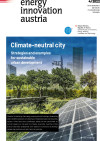
Strategies and examples for sustainable urban development
energy innovation austria
4/2022
Herausgeber: BMK in cooperation with the Climate and Energy Fund
Englisch, 12 Seiten
Downloads zur Publikation
Summer University "Green.Building.Solutions. (GBS)"
15. July - 6. August 2023
Vienna, AT
First-hand ecological knowledge and engineering expertise bundled in a three-week program, taking place at the capital of energy-efficient building, Vienna. Think sustainable, take care of your future - now!
Digital technologies
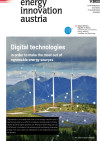
Digital technologies in order to make the most out of renewable energy sources.
energy innovation austria
1/2022
Herausgeber: BMK in cooperation with the Climate and Energy Fund
Englisch, 12 Seiten
Downloads zur Publikation
Artificial Intelligence and 5G Technologies in future Integrated Energy Systems
29. April 2019, 9 a.m. to 5 p.m.
Austrian Ministry for Transport, Innovation and Technology, Radetzkystraße 2, 1030 Vienna, Room EA 08
At the Mission Innovation Austria Week Pre-Event state of the art of AI and 5G technologies and ongoing projects were presented and discussed.
Smart Energy Systems
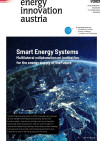
Multilateral collaboration on innovation for the energy supply of the future
energy innovation austria
1/2021
Herausgeber: BMK in cooperation with the Climate and Energy Fund
Englisch, 16 Seiten
Downloads zur Publikation
Heat from the depths
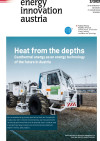
Geothermal energy as an energy technology of the future in Austria
energy innovation austria
2/2021
Herausgeber: BMK in cooperation with the Climate and Energy Fund
Englisch, 12 Seiten
Downloads zur Publikation
Transparent Thermal Insulation
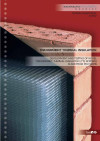
Development and Testing of novel Transparent Thermal Insulatio (TTI) Systems made from Polymers
Forschungsforum
2/2002
Herausgeber: BMVIT
Englisch, 6 Seiten
Downloads zur Publikation
Biogas as Vehicle Fuel - Economic Feasibility in Austria
The main objectives of this project are to discuss the economic feasibility of the production and distribution of biogas used as transportation fuel and to identify those types of local distribution systems that are already economically feasible under the present economic conditions in Austria.
OPEN HEAT GRID - Open Heat Grids in urban hybrid systems
The primary research topic of OPEN HEAT GRID was to investigate the possibilities of enforcing the feed-in of industrial waste heat into existing district heating networks. The project results show that excess heat is not for free: despite minimal variable costs, the investment costs need to satisfy usual payback periods. The analysis shows that there is no need for a regulation in the sense of a feed-in obligation or market liberalization. However, from an economic point of view, information asymmetries exist, which may lead to irrational decisions.
IEA Hydrogen TCP Task 41 Final Workshop
11. September 2023, 10:00 - 12:00
Teams Meeting, ES
The main objectives of Task 41 are to provide an updated and continuously updatable long-lasting database on hydrogen technologies allowing improved modelling, understanding and decision-making. Additionally, the Task aims to establish a closer collaboration between the Hydrogen Technology Collaboration Program (TCP) and the Energy Technology Systems Analysis Program (ETSAP) community.
Bioenergy in a Net Zero Future
19. October 2023
Hôtel Mercure – Lyon Centre Charpennes, 7 place Charles Hernu, 69100 Villeurbanne, Lyon, FR
This workshop aims to discuss the role of bioenergy in the transition to a carbon neutral energy systems. The focus will be on policies and strategies to support the role of bioenergy in the energy transition and on the flexibility of bioenergy in the energy system, the use of biogenic CO2 and promising developments in bioenergy concepts.
Biobased Industry

Austrian strategies for producing from renewable raw materials
energy innovation austria
3/2015
Herausgeber: BMVIT and Climate and Energy Fund
Englisch, 8 Seiten
Downloads zur Publikation
Digitization in the construction and real estate industry
In the multitude of digital possibilities, it is very difficult to maintain an overview, to assess trends and potentials, and to recognize correlations. This report therefore aims to describe the current state of the art and the market assessment of promising digital technologies. Information is provided on concrete use cases, added value and challenges of the respective technologies. The analyses presented serve to assess the potential and set the strategic course for the integration of the currently most important digital technologies in the construction and real estate industry.
Energetic building refurbishment in protection zones

Standardized solutions as a help and guideline for building-owners, authorities and companies
